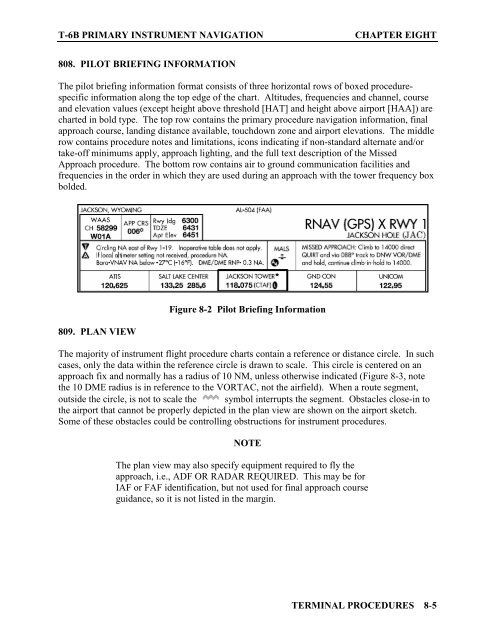Flight Training Instruction - Cnatra - U.S. Navy
Flight Training Instruction - Cnatra - U.S. Navy
Flight Training Instruction - Cnatra - U.S. Navy
You also want an ePaper? Increase the reach of your titles
YUMPU automatically turns print PDFs into web optimized ePapers that Google loves.
T-6B PRIMARY INSTRUMENT NAVIGATION CHAPTER EIGHT<br />
808. PILOT BRIEFING INFORMATION<br />
The pilot briefing information format consists of three horizontal rows of boxed procedurespecific<br />
information along the top edge of the chart. Altitudes, frequencies and channel, course<br />
and elevation values (except height above threshold [HAT] and height above airport [HAA]) are<br />
charted in bold type. The top row contains the primary procedure navigation information, final<br />
approach course, landing distance available, touchdown zone and airport elevations. The middle<br />
row contains procedure notes and limitations, icons indicating if non-standard alternate and/or<br />
take-off minimums apply, approach lighting, and the full text description of the Missed<br />
Approach procedure. The bottom row contains air to ground communication facilities and<br />
frequencies in the order in which they are used during an approach with the tower frequency box<br />
bolded.<br />
809. PLAN VIEW<br />
Figure 8-2 Pilot Briefing Information<br />
The majority of instrument flight procedure charts contain a reference or distance circle. In such<br />
cases, only the data within the reference circle is drawn to scale. This circle is centered on an<br />
approach fix and normally has a radius of 10 NM, unless otherwise indicated (Figure 8-3, note<br />
the 10 DME radius is in reference to the VORTAC, not the airfield). When a route segment,<br />
outside the circle, is not to scale the symbol interrupts the segment. Obstacles close-in to<br />
the airport that cannot be properly depicted in the plan view are shown on the airport sketch.<br />
Some of these obstacles could be controlling obstructions for instrument procedures.<br />
NOTE<br />
The plan view may also specify equipment required to fly the<br />
approach, i.e., ADF OR RADAR REQUIRED. This may be for<br />
IAF or FAF identification, but not used for final approach course<br />
guidance, so it is not listed in the margin.<br />
TERMINAL PROCEDURES 8-5
















